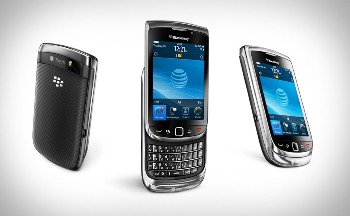BlackBerry Torch Is Better For Business Than iPhone: Review

Apple’s integrated combination of hardware and software is compelling, but can’t hold a candle to RIM’s business features, as seen in the BlackBerry Torch 9800
Power
In terms of raw horsepower it’s no contest, as the iPhone sports a 1GHz processor built on ARM’s Cortex A8 core (designed and promoted by Apple as the “A4”), while the Torch comes with a decidedly last-generation 624MHz processor and 512MB of flash memory for applications. Nevertheless, Andrew didn’t feel the impact of the lesser horsepower in tests, as the Torch responded quickly when opening or moving between applications.
Like earlier iPhones, the iPhone 4 was designed with a built-in battery (third-party teardown reports indicate a 1420 mAh battery), which promises much longer battery life than the removable 1270 mAh battery of the Torch (model FS-1). The Torch’s specifications list 5.8 hours of 3G talk time, versus the iPhone’s claimed 7 hours. Media playback follows a similar pattern: 6 hours of video on Torch to the iPhone’s 10 hours, and 30 hours of audio on Torch to 40 hours on the iPhone. In practice, Andrew found the Torch used its smaller battery efficiently, finding that he typically needed to charge it only after two days of common, moderate usage. Similarly, P. J. found that the iPhone 4’s battery holds up well on standby, but processor-intensive operations (such as viewing HD video) could put a noticeable dent in the battery’s lifespan.
Both devices offer an accelerometer and GPS location services for applications, and geotagging features are built into the stock photo and video applications. The Torch lacks the iPhone’s three-axis gyro and compass but does offer a proximity light sensor, which worked a little too well, as Andrew kept managing to mute calls with his cheek.
Operating systems and apps
P. J. took an extensive look at the iPhone’s iOS 4 earlier in 2010; the most prominent features of iOS 4 that couldn’t be tested on the equipment we had in hand at that time are FaceTime video chat and the ability to edit HD video with iMovie for iPhone, which Apple sells in the iTunes App Store for $4.99 (the Torch really doesn’t have anything that compares to either).
The Torch comes with the new BlackBerry 6 operating system, and the two combine to deliver a vastly superior touch-screen experience than on older BlackBerrys such as the Storm. Like the iPhone, the Torch utilises now-familiar pinch and spread gestures for zoom actions, along with swipes and double-taps for screen navigation. RIM will undoubtedly release future BlackBerry 6 devices without a touch screen, however, so the OS must straddle two worlds, and the legacy of BlackBerry’s myriad menus and hotkeys is also still apparent in the Torch, leading to a slightly schizophrenic user experience.
Along with BlackBerry 6, RIM released the next version of its BlackBerry App World app store, which thankfully does away with the reliance on PayPal as the only supported method of payment; credit cards can now be used as well. Users must create a new BlackBerry ID to download apps from BlackBerry App World, and will have the opportunity to port previously purchased apps over to the new BlackBerry ID account.
Despite that and other small improvements, however, BlackBerry App World is still a far cry from the App Store experience, lacking the ease of exploration, breadth of recommendations and raw volume of available applications.